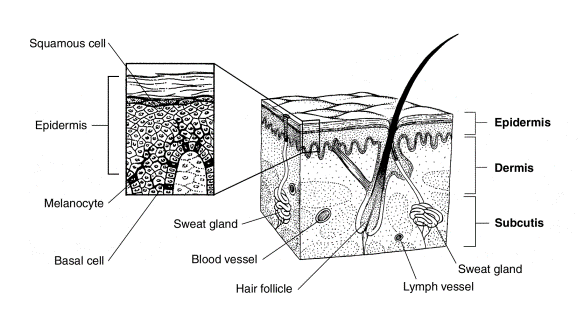The human body’s largest organ is the skin, which provides numerous functions including protection and temperature regulation. There are three layers of human skin: the epidermis (outer layer), the dermis (inner layer) and the hypodermis (innermost layer of skin which is used to reserve energy in the form of fat). The skin can be quite delicate, as many people know, overexposure to harmful UV rays (in the sun on a hot day, or using a tanning bed) can lead to complications such as squamous cell skin carcinoma.

What Is a Squamous Cell Skin Carcinoma?
The top layer of skin, epidermis, is comprised mostly of squamous cells. When harmful and abnormal cells begin to develop and grow, it is known as squamous cell carcinoma (SCC). This type of skin cancer, if left untreated, can spread to bones, tissue, and the lymph nodes, making it extremely difficult to treat and possibly leading to fatality. Thankfully, if caught early, the disease is easily treatable. It is estimated that around 700,000 people are diagnosed with squamous skin carcinoma per year in the United States, of which around 3,900-8,800 people unfortunately passed away as a result of the illness.
Causes and Risk Factors
As stated, a common cause of squamous cell skin carcinoma is over exposure to UV rays. This means that anyone who spends a lot of time outdoors, be it for work or leisure, is at an increased risk of developing SCC. There are other instances where the likelihood of you developing this disease is increased, including:
- If you have fair/light skin/hair.
- If you have a history of prolonged UV exposure.
- If you have or have had basal cell carcinoma.
- If you have a genetic condition that causes increased UV sensitivity, xeroderma pigmentosum, for example.
The disease is almost twice as common in men as it is in women, although the number of cases in women has risen dramatically recently, which some attribute to the increase popularity of sun-bed tanning. It is thought that if you use a sun-bed regularly, you are two and a half times more likely to develop SCC. Another risk factor to note is skin injury. If your skin is burned, scarred, or damaged in another way, SCC can develop at the sight of the injury. Although the disease is more common in light-skinned people, people with all skin types should practice proper skin-care and sun protection to avoid the development of SCC.
Symptoms
The most common areas to be affected by squamous cell skin carcinoma are the face, neck, ears, arms, or hand. That being said, it is possible for SCC to develop on other areas. The most common symptoms of SCC include:
- A lump or bump, which can have a scaly, rough surface
- Reddish patches (can be scaly/crusty)
- Sore throat which does not seem to heal
- Changes in existing moles, warts, or similar skin lesions
Diagnosis and Treatment Options for Squamous Cell Skin Carcinoma
Diagnosis
If you believe that you may have SCC, then you should visit a health care professional to undergo proper testing. This will begin with an initial observation of your skin, where your doctor will check any suspicious areas for telling signs of a malignant disease. If it is indeed suspected that you could have SCC, then you will likely undergo a skin biopsy, whereby a small section of your skin will be removed for further examination via a microscope. This is perhaps the best known way to test for all types of skin cancers.
Early Stage Treatment Options
- Chemotherapy cream: This is used to treat squamous cell skin carcinoma in the early stages, containing 5-fluorouracil (5-FU), a drug used in chemotherapy.
- Laser treatment: If the SCC is on the outermost layer of the skin, a laser can be used to eradicate the abnormal cells. This is generally only recommended during the early stages of SCC.
- Photodynamic therapy (PTD): The process includes two steps: the application of a chemical to the skin which is absorbed, and then exposure of the skin to a specialized light manufactured to kill abnormal cancer cells.
Surgeries
- Excision: This procedure can often be performed during a visit to your dermatologist. It involves a health care professional surgically removing the skin where the tumor is, as well as the healthy skin which surrounds it (once the area has been numbed). The removed skin is then examined, if the normal looking skin (that which surround the affected area) shows cancer cells, then more skin will require removal.
- Mohs surgery: This surgery is much like an excision as it involves a surgeon removing the tumor and the surrounding skin. The healthy-looking skin is then tested for cancer cells, if present, the procedure is carried out again, until no cancer cells can be detected.
- Radiation: If the SCC is too severe and cannot be safely removed, then radiation treatment is often offered. In this instance, you may require up to 30 treatments of radiation to banish the malicious disease.
